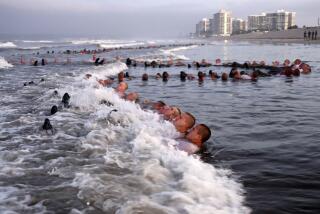Navy Puts Blame for $164,000 Icebox Snafu on Series of Human Errors : Investigation: The 178 cold-storage food boxes were never used because there was no building large enough to chill them.
- Share via
A series of errors led San Diego Navy officials to spend $164,000 on 178 cold-storage boxes that were never used for pierside refrigeration because the Navy lacked a facility large enough to chill the boxes, according to an investigation by the Naval Inspector General.
“The execution of this procurement can best be characterized as a string of individual errors, (generally well-intentioned, but errors nonetheless),” said Rear Adm. M. E. Chang, in a recent letter to Rep. Jim Bates (D-San Diego). Bates had written to Chang requesting an investigation of the purchase last winter.
The boxes, 4 feet by 4 feet by 7 feet, were designed to be chilled in a cold warehouse, loaded with food and taken to piers to await ships. But there were problems. Since the supply center didn’t have a facility big enough to chill the boxes, the boxes were put in an outdoor boat lot for two years, where some rusted. A few were used to store paint.
“The real waste in this case lies in the fact that these boxes are not being used for their intended purpose. Every indication observed by my investigator is that they work very well,” said Chang, in his five-page letter. Chang was unavailable for an interview Friday, but Washington Navy spokesman Lt. Greg Smith said the letter fairly depicted Chang’s position.
After reading the letter, Bates said the procurement had been bungled worse than he had originally believed.
“Everyone involved handled this wrong. I just hope it’s not typical--because, if it is, we have a culture of incompetence in the Navy,” Bates said. “We have got to start handling these matters in a more businesslike manner. People have got to feel more of a stake--the taxpayer’s dollar has got to be treated as though it were their own.”
Officials with the supply center were unavailable for comment on Chang’s report. When The Times first reported the purchase of the boxes in February, officials had acknowledged that the procurement was inappropriate.
“It was a waste of government funds,” said Mary Giffin, director of management control and review at the supply center, during an earlier interview.
Naval supply officials in San Diego purchased the insulated boxes in December 1985. They hoped the purchase would save $300,000 by reducing the number of workers waiting by docks for ships and decreasing the amount of fuel used by trucks waiting with their engines running.
The supply center provides food and supplies to 140 ships in San Diego and Long Beach. It also services 344 shore facilities, including the Naval Hospital in Balboa Park.
In 1981, the San Diego supply center purchased five cold storage boxes from the Bill Rivers Co. in Florida. These were used as part of an experiment to transport frozen food to Long Beach, Camp Pendleton and Fallbrook. Two years later, officials decided they had sufficient positive feedback to purchase more boxes.
Glitches then began to pile up. Though they should have been identical, the contract specification forms were different from the contract solicitation forms, according to Chang. Although the mistaken difference in the two forms should have been caught, it wasn’t.
The contracting officer used the wrong specifications when trying out the boxes and mistakenly rejected the boxes, saying they didn’t work adequately, Chang said. Then the supply center’s Internal Review Office was called in to investigate after a complaint was filed in connection with the boxes, but the auditors “did not thoroughly investigate,” Chang said.
Instead, the investigation “highlighted the under-utilization of the reefer boxes and created the misconception that the boxes’ performance was less than required,” Chang said.
Although they lacked a place large enough to chill the boxes, officials went ahead with the purchase--in spite of the contracting officer’s rejection--because the Navy had planned to construct the facility. When the funding for the construction was canceled, the officials still purchased the boxes because they believed the Navy might lease a facility and because they wanted “to avoid the penalty for defaulting,” Chang said in his letter.
But, because no facility was leased, the boxes were put in the only storage space available--the outdoor boat lot. When supply center officials received a complaint about the boxes deteriorating in the lot, they shipped them to other bases for a cost of $2,000, Chang said. Fifty-seven boxes were shipped to Pearl Harbor in Hawaii and Subic Bay in the Philippines. Others were sent to Charleston, S.C., Puget Sound, Wash., and Pensacola, Fla., and 55 were distributed in the San Diego area, according to Chang.
In an effort to rectify the situation, Chang is trying to set up a program to use the boxes. No one responsible for the mistakes is still in government service, said Chang, who made no mention of punitive actions.
To prevent botched purchases, the Navy is shoring up the way it does business, Chang said.
More to Read
Sign up for Essential California
The most important California stories and recommendations in your inbox every morning.
You may occasionally receive promotional content from the Los Angeles Times.













